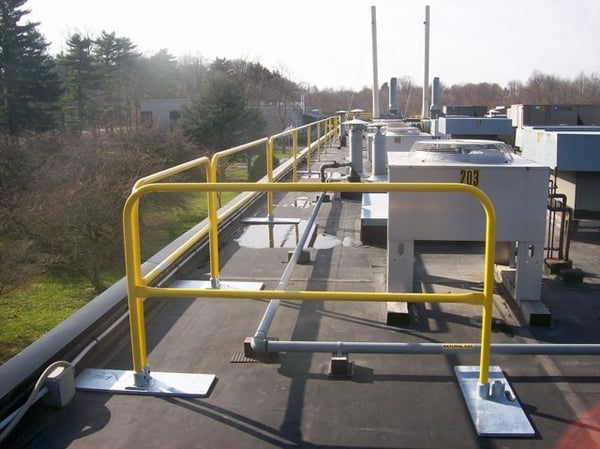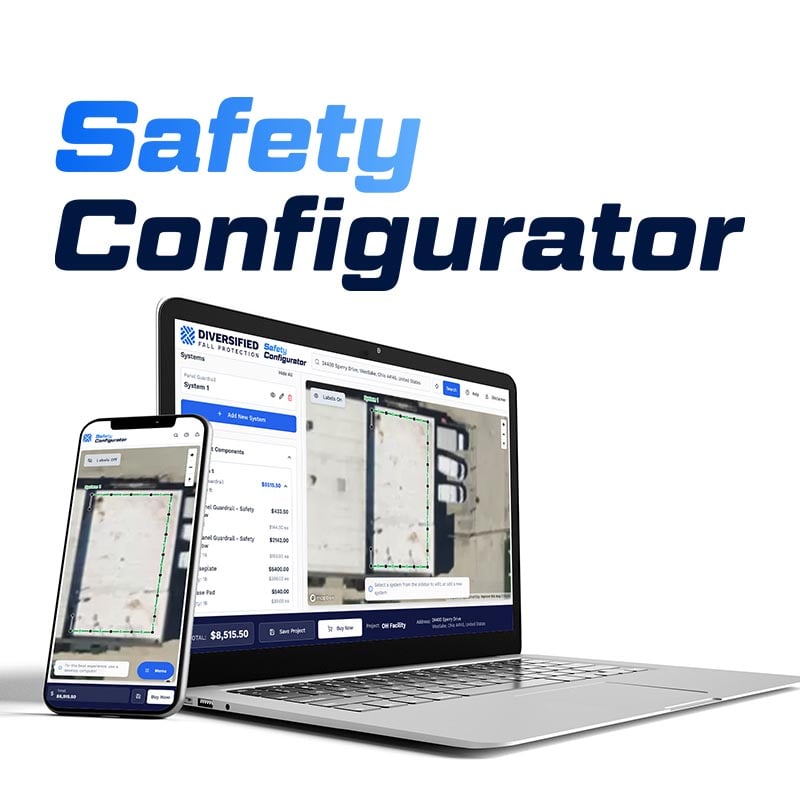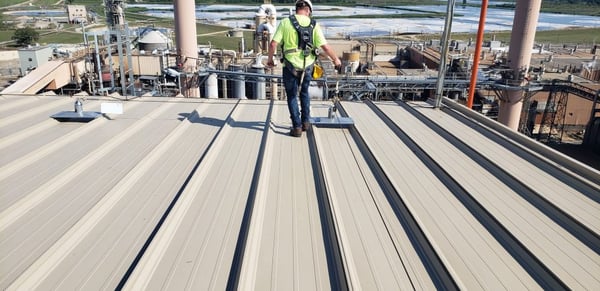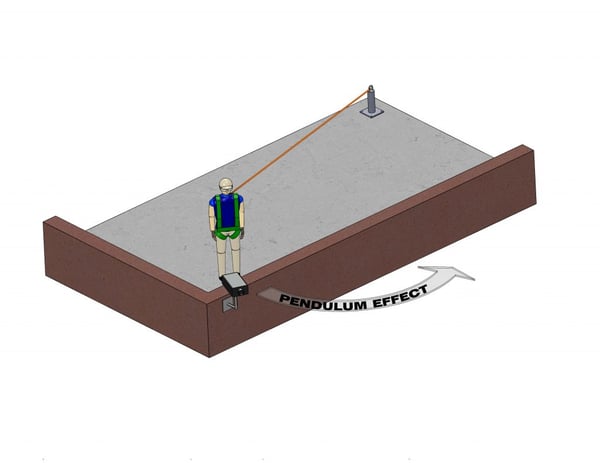How to Specify Rooftop Fall Protection
Roof replacement is an ideal time to address rooftop fall protection issues. Design of effective and practical solutions to suit the owner’s specific rooftop maintenance needs is critical. The fall protection marketplace offers an endless array of products, but there is no “one-size-fits-all” solution. Rather, the appropriate solution will vary based on a fall hazard survey, as well as on architectural and budgetary constraints.
ANSI/ASSE Z359.2-2007 establishes minimum requirements for a comprehensive, managed fall protection program. These requirements should be addressed in the design and construction phase. This ensures that the installed fall protection system can support the owner’s maintenance needs and fall protection procedures now and into the future. Essential to the design process is a fall hazard survey which serves to identify fall hazards and one or more methods to eliminate or control each identified hazard (Section 4.2.1). The designer should consult with an owner-designated competent person who is familiar with rooftop maintenance activities and methods. The survey should identify applicable factors such as the reason for the exposure, possible severity of a fall, maintenance frequency, task duration, environmental conditions, and history of incidents related to the task (section 4.2.5). For example, risk factors associated with access to gutters for cleaning on a sloped roof will vary significantly from those related to access to a security camera near an unprotected edge on a flat roof.
Once hazards are identified, use the fall protection hierarchy as a preferred order of elimination or control for each identified hazard (section 5.1). The first and most effective control measure is to eliminate the identified fall hazard (section 5.1.1). As an example, can leaf guards be installed on gutters that require access from a steep-slope metal roof area? The second preferred control is to provide passive fall protection—typically a guardrail system to provide protection along a roof edge or furnishing a compliant cover for roof openings such as skylights (section 5.1.2). In addition to traditional structure-mounted guardrail systems, non-roof-penetrating guardrails are also available. Systems such as the one shown in Figure 1 are ballasted and designed to meet OSHA load requirements.
Figure 1 – Ballasted Guardrail System
Passive fall protection solutions are always preferred, but especially when the exposure is high-frequency and the area is accessible to personnel that have not been trained to use active fall protection systems. In some cases, guardrail systems are not practical for low-frequency tasks. Architectural requirements may prohibit installation of a system that is visible from street level. In those cases, a travel restraint system is the next preferred control. It provides anchorage and a body harness with a properly sized lanyard that is short enough to prevent the user from reaching the fall hazard (section 5.1.3). Travel restraint systems are limited to low-slope roof areas with pitch not to exceed 4:12 (section 5.2.6). The primary objective for an effective fall protection design should provide controls that keep the user from the roof edge and from experiencing a fall event. But such controls are sometimes not possible given the building parameters and access requirements. In those cases, a fall arrest system should be designed to safely arrest the user after a fall has begun. Provision should be made for timely rescue of the suspended worker in the event of a fall. Travel restraint and fall arrest systems are both categorized as active fall protection systems and require specialized training in order to designate personnel as “authorized users.”
For active fall protection systems, connection to an anchorage point located above a user is most desirable. An overhead connection will best limit the user’s maximum free-fall distance. However, for rooftop applications, connection is generally to an anchor that is designed with an attachment to suit the existing roof structure. Anchorage systems are typically low-profile, minimizing design loads to the existing structure and, therefore, minimizing structural modification and bracing if required. Single-point anchors and horizontal lifelines are the most common forms of anchorage for active rooftop fall protection systems. Single-point anchors are generally composed of a baseplate with attachment hardware and a vertical post to include a point of connection compatible with self-locking snaphooks and carabiners. Horizontal lifelines are generally composed of a cable system supported by anchors attached to the structure. While single-point anchors provide user access to point locations on the roof, horizontal lifelines allow continuous mobility along a fall hazard. Specifications for horizontal lifelines vary, and certain products require that the user detach and reattach his or her lanyard for bypass at intermediate anchor locations (typically with a double-leg lanyard). Other products have the added cost and benefit of continuous bypass through intermediate anchor locations by means of specialty post brackets and integrated travelers as shown in Figure 2.
When access is required along a building edge, horizontal lifelines are an intuitive approach. The lanyard is sized to prevent the user from reaching the fall hazard and creating a pendulum effect. The geometry of such a system prohibits the user from extending along the building edge, away from perpendicular, to the extent that the user could experience a dangerous swing fall as shown in Figure 3. Single-point anchors also provide effective fall protection anchorage. They do, however, require the user to be mindful of lanyard length compared to the distance of the anchor from closest building edge. This system is best suited for maintenance activities that do not require access to the entire perimeter or when maintenance is less frequent.
Also critical for a complete design is to ensure that there is an adequate means to safely access the installed system. For example, a horizontal lifeline along the ridge of an 8:12 pitched roof would require an access lifeline from eve to ridge if access is by ladder or lift from the roof eave.
Design, selection, and installation of certified active fall protection systems should be under the supervision of a qualified person (section 5.4). Certification of the anchorage point should include analysis of the anchorage system and applied loads to the existing structure by a qualified fall protection engineer. For bidding and budgetary purposes, it is helpful to include a layout that indicates the extent of the desired system and a specification that details the performance and design requirements. Fall protection manufacturers often provide assistance with conceptual layout and details for bidding purposes.
For active fall protection systems, the installed system should include provision for training of the owner’s personnel as system authorized users. End-user equipment, such as harnesses and lanyards, should be designated and included as part of the system package. Otherwise, a qualified person should review any existing owner equipment and determine compatibility with the installed system.
Travis Nelson, PE
Peak Fall Protection, Inc
A Diversified Fall Protection Company
References
ANSI/ASSE Z359.2-2007 Minimum Requirements for a Comprehensive Managed Fall Protection Program
Schedule an assessment with Diversified Fall Protection
Contact Us to request a fall safety review

b-1.jpg?width=1368&height=1340&name=Rail%20(175)b-1.jpg)



